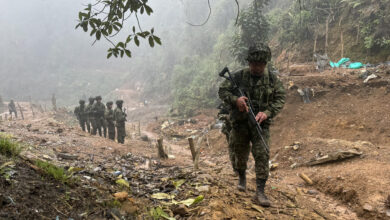Amazon River Petroglyphs: Unveiling Ancient Secrets Amid Historic Drought
The emergence of these ancient petroglyphs along the Amazon River's shores is a momentous discovery, shedding light on the prehistoric or precolonial history of the region. As researchers work diligently to unravel the mysteries of these carvings, the importance of preserving and respecting this archaeological site cannot be overstated

Photo: National Geographic
The Latin American Post Staff
Escucha este artículo
Leer en español: Petroglifos del río Amazonas: revelando secretos antiguos en medio de una sequía histórica
Unprecedented Drought Reveals Hidden Carvings
As a historic drought grips the Brazilian Amazon region, water levels along the Amazon River have dropped to unprecedented lows, revealing a hidden treasure trove of ancient petroglyphs etched into stone. These remarkable carvings, depicting human faces, animals, and natural forms, have resurfaced on the shores of the Rio Negro, at the archaeological site known as Ponto das Lajes, or Place of Slabs. The significance of this discovery, along with insights into the carvings' age and cultural significance, are explored in this feature analysis.
The petroglyphs in question, including anthropomorphic faces and depictions of water, represent an extraordinary glimpse into the past. When researchers first spotted these carvings during a severe drought in 2010, the water levels of the Rio Negro had dropped to 13.63 meters, then considered an all-time low. However, this year's drought has proven even more severe, with the Rio Negro sinking below 13 meters for the first time in recorded history, reaching a depth of 12.89 meters on a recent measurement.
A Whetstone of History: Tool Preparation
Carlos Augusto da Silva, an archaeologist from the Federal University of Amazonas, identified 25 groups of carvings on a single rock, suggesting that it served as a whetstone for sharpening various tools and instruments. These grooves offer valuable insight into the practical uses of the site and indicate that it was an area for tool preparation. This aspect of the petroglyphs demonstrates their cultural and practical significance.
The presence of grooves on the rocks is a significant revelation. These grooves are believed to have been used by Indigenous inhabitants for sharpening their arrows and spears long before Europeans arrived in the region. The carvings and sharpening marks provide a tangible link to the prehistoric or pre-colonial past of the Amazon region.
Rich History Unearthed: Ceramics and Indigenous Villages
Despite the site being designated as an archaeological area, the Ponto das Lajes petroglyphs had yet to be studied in-depth. Researchers have had to estimate the age of the carvings based on similar rock carvings found in other parts of central Amazonia. The presence of fragments of ceramics thought to be thousands of years old, has also been reported at the site, underlining the rich history of this location. In pre-Columbian times, this area was home to large Indigenous villages, making it a significant place for studying the region's ancient Indigenous history.
The unprecedented exposure of these petroglyphs is closely linked to environmental factors. The ongoing historic drought, attributed to the El Niño weather pattern and the warming of the North Atlantic associated with the climate crisis, has contributed to record-low water levels in the Rio Negro. These natural events, while causing hardships, have inadvertently unveiled a glimpse of the past and are a testament to the dynamic relationship between nature and archaeology.
Also read: Brazil: New Project To Mitigate Polluting Gases From Cows
Unlocking Origins: Research and Preservation
Archaeologists and researchers, led by Jaime de Santana Oliveira of the Institute for Public Health and Medicine (IPHAM), have been working to document and study these ancient carvings. Their goal is to establish the origins of these petroglyphs and gain a better understanding of the cultural and historical context in which they were created.
The National Historical and Artistic Heritage Institute (IPHAN) is responsible for overseeing the preservation of historic sites in Brazil, including the Ponto das Lajes petroglyphs. The exposure of these ancient carvings has prompted renewed efforts to ensure their protection and conservation for future generations.




